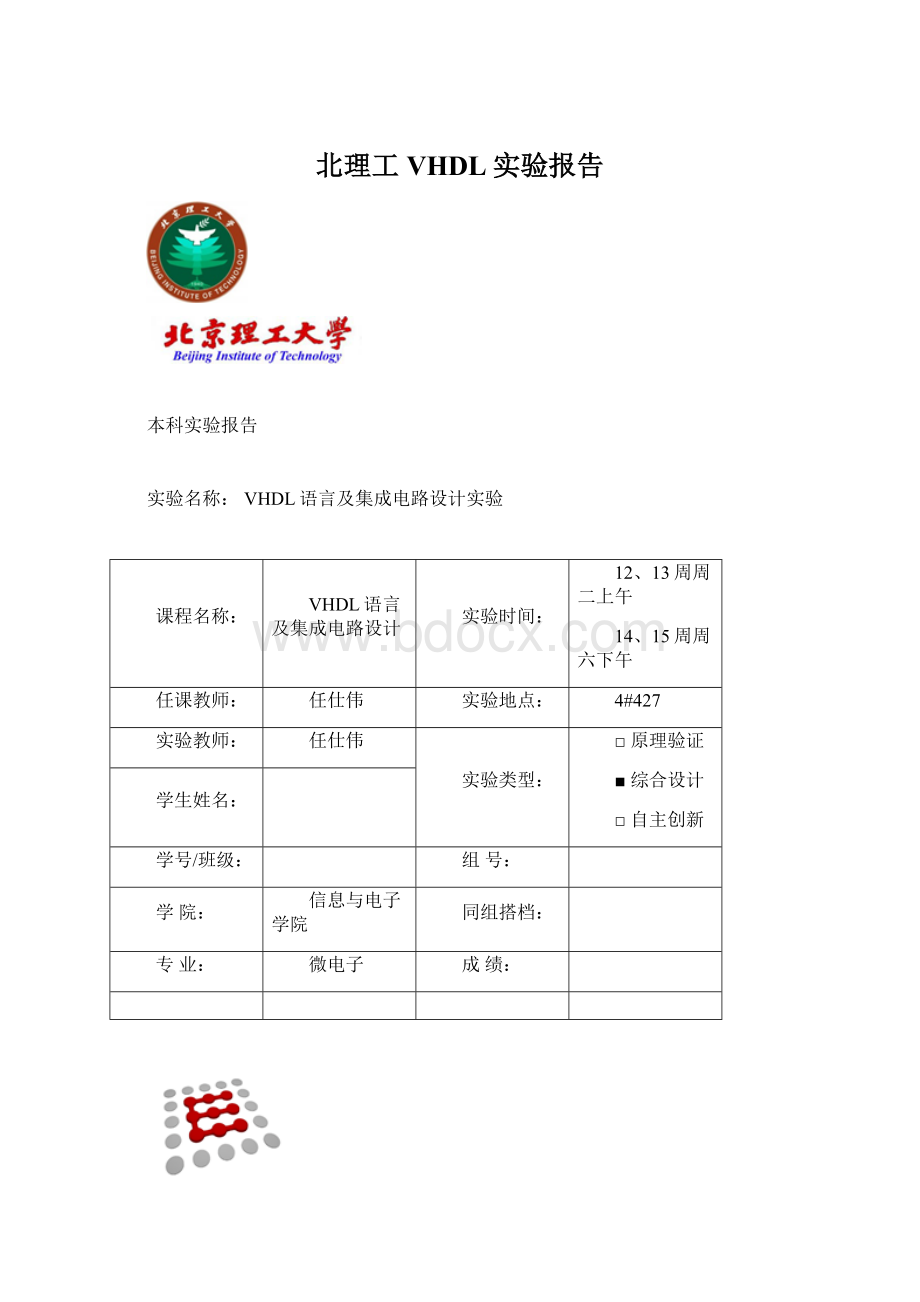北理工VHDL实验报告.docx
《北理工VHDL实验报告.docx》由会员分享,可在线阅读,更多相关《北理工VHDL实验报告.docx(23页珍藏版)》请在冰豆网上搜索。

北理工VHDL实验报告
本科实验报告
实验名称:
VHDL语言及集成电路设计实验
课程名称:
VHDL语言及集成电路设计
实验时间:
12、13周周二上午
14、15周周六下午
任课教师:
任仕伟
实验地点:
4#427
实验教师:
任仕伟
实验类型:
□原理验证
■综合设计
□自主创新
学生姓名:
学号/班级:
组号:
学院:
信息与电子学院
同组搭档:
专业:
微电子
成绩:
实验一:
带有异步复位端的D触发器
一、实验目的
(1)熟悉linux操作环境和modelsim软件环境
(2)理解时序逻辑和组合逻辑电路的区别
(3)理解并行语句和顺序语句
(4)用VHDL语言编写一个带有异步复位端的D触发器及其测试文件
二、实验原理
(1)组合逻辑和时序逻辑
组合逻辑电路当前输出的值仅取决于当前的输入,不需要触发器等具有存储能力
的逻辑单元,仅仅使用组合逻辑门;
时序逻辑电路的当前输出不仅取决于当前的输入,还与以前的输入有关,这类电
路中包括寄存器等元件,也包括组合逻辑电路,寄存器通过一个反馈环和组合逻辑模块相连,触发器便是属于时序逻辑电路;
(2)并行和顺序代码
从本质上讲,VHDL代码是并发执行的。
只有PROCESS,FUNCTION或PROCEDURE内的代码才是顺序执行的。
当它们作为一个整体时,与其他模块之间又是并发执行的。
以下是3个并发描述语句(stat1,stat2和stat3)的代码,会产生同样的电路结构。
stat1stat3stat1
stat2=stat2=stat3=其他排列顺序
stat3stat1stat2
(3)并行语句——进程(PROCESS)
1)语法结构:
[进程名:
]PROCESS(敏感信号列表)
[变量说明语句]
…
BEGIN
…
(顺序执行的代码)
…
ENDPROCESS[进程名];
2)PROCESS的特点
多进程之间是并行执行的;
进程结构内部的所有语句都是顺序执行的;
进程中可访问结构体或实体中所定义的信号;
进程的启动是由敏感信号列表所标明的信号来触发,也可以用WAIT语句等待一个触发条件的成立。
各进程之间的通信是由信号来传递的。
(4)带有异步复位端的D触发器
三、实验代码
LIBRARYIEEE;
USEIEEE.STD_LOGIC_1164.ALL;
ENTITYdffIS
PORT(d,clk,rst:
INSTD_LOGIC;
q:
OUTSTD_LOGIC);
ENDdff;定义entitydff
ARCHITECTUREbehaviorOFdffISBEGIN
PROCESS(rst,clk)
BEGIN
IF(rst='1')THEN
q<='0';如果复位信号有效,q为0
ELSIF(clk'EVENTANDclk='1')THENq<=d;上升沿触发且,q<=d
ENDIF;
ENDPROCESS;结束进程
endARCHITECTUREbehavior;
测试文件:
libraryIEEE;
useieee.std_logic_1164.all;
entitydff_tbis
enddff_tb;
architecturetb_behaviorofdff_tbiscomponentdff
port(
d,rst,clk:
instd_logic;
q:
outstd_logic);
endcomponent;
constantclk_period:
time:
=50ns;
signald,clk,q,rst:
std_logic;
begin
dut:
dffportmap(d=>d,clk=>clk,rst=>rst,q=>q);clk_gen:
process
begin
clk<='0';
waitforclk_period/2;clk<='1';
waitforclk_period/2;endprocess;
d_gen:
process
begin
waitfor100ns;
d<='1';
waitfor100ns;
d<='0';
endprocess;
rst_gen:
process
begin
rst<='1';
waitfor150ns;
rst<='0';
waitfor500ns;
rst<='1';
waitfor150ns;wait;
endprocess;
endtb_behavior;
四、实验结果
五、实验心得
第一次使用此软件,略有陌生,耗费时间稍久,因为之前用过的quartusii9.0不必使用tb文件,所以第一次实验刚开始并没有明白tb文件的用途,上网查找资料之后才明白过来,不过好在程序简单,顺利完成实验。
实验二步进电机控制器
一、实验目的
(1)理解两种状态机的区别
(2)熟悉两种编程风格
(3)编写BCD计数器和步进电机
二、实验原理
(1)米里型状态机和摩尔型状态机
米里(Mealy)型状态机:
状态机的输出信号不仅与电路的当前状态有关,还与当前的输入有关
摩尔(Moore)型状态机:
状态机的当前输出仅仅由当前状态决定。
(2)有限状态机设计流程:
1)理解问题背景。
2)逻辑抽象,得出状态转移图。
3状态简化。
4)状态分配。
5)用VHDL来描述有限状态机。
(3)BCD计数器
原理图
(4)步进电机控制器
三、实验代码
(1)BCD计数器
libraryieee;
useieee.std_logic_1164.all;
entitycounteris
port(clk,rst:
instd_logic;
count:
outstd_logic_vector(3downto0));
endcounter;定义entitycounter
architecturestate_machineofcounteris
typestateis
(zero,one,two,three,four,five,six,seven,eight,nine);自定义type类型的量,用来表示程序中要用到的不同状态
signalpr_state,nx_state:
state;定义信号pr_state,nx_state,均为state类型的量
begin
process(rst,clk)
begin
if(rst='1')then
pr_state<=nx_state;如果复位信号有效,保持现态
endif;
endprocess;
process(pr_state)
begin
casepr_stateis
whenzero=>count<="0000";
nx_state<=one;
whenone=>count<="0001";
nx_state<=two;
whentwo=>count<="0010";
nx_state<=three;
whenthree=>count<="0011";
nx_state<=four;
whenfour=>count<="0100";
nx_state<=five;
whenfive=>count<="0101";
nx_state<=six;
whensix=>count<="0110";
nx_state<=seven;
whenseven=>count<="0111";
nx_state<=eight;
wheneight=>count<="1000";
nx_state<=nine;
whennine=>count<="1001";
nx_state<=zero;
endcase;使用case语句,列举所有状态,同时指出所有现态的次态指向
endprocess;
endstate_machine;
(2)步进电机控制器
libraryieee;
useieee.std_logic_1164.all;
entitystepmotoris
port(clk,rst,x:
instd_logic;
output:
outstd_logic_vector(3downto0));
endstepmotor;定义entitystepmoter
architecturestate_machineofstepmotoris
typestateis
(s0,s1,s2,s3);自定义type类型
signalpr_state,nx_state:
state;定义信号量
begin
process(clk,rst)
begin
if(rst='1')then
pr_state<=s0;
elsif(clk'eventandclk='1')then
pr_state<=nx_state;
endif;
endprocess;
process(pr_state,x)
begin
if(x='0')then
casepr_stateis
whens0=>output<="0001";
nx_state<=s3;
whens1=>output<="0010";
nx_state<=s0;
whens2=>output<="0100";
nx_state<=s1;
whens3=>output<="1000";
nx_state<=s2;
endcase;
elsif(x='1')then
casepr_stateis
whens0=>output<="0001";nx_state<=s1;
whens1=>output<="0010";nx_state<=s2;
whens2=>output<="0100";nx_state<=s3;
whens3=>output<="1000";nx_state<=s0;endcase;
endif;
endprocess;
endstate_machine;
四、仿真结果
BCD计数器:
步进电机控制器:
五、实验心得
这次所做实验为BCD计数器和步进电机控制,程序比较简单,有可以使用的模板,结果也比较有意思,主要是对状态机的理解运用和VHdl语句中例如case语句、if语句、when语句的区分和正确使用。
实验三十六位加法器设计
一、实验目的
(1)掌握元件例化的方法
(2)理解for/generate语句的用法
(3)编程完成4位加法器和16位加法器的设计
二、实验原理
(1)元件的例化
元件声明是对VHDL模块(即底层设计,也是完整的VHDL设计)的说明,使之可在其他被调用,元件声明可放在程序包中,也可在某个设计的构造体中声明。
元件例化指元件的调用。
元件声明及元件例化的语法分别如下:
元件声明:
component〈元件实体名〉
prot(〈元件端口信息,同该元件实现时的实体的port部分〉);
endcompnent;
元件例化:
〈例化名〉:
〈实体名,即元件名〉portmap(〈端口列表〉);
(2)生成语句(GENERATE)
GENERATE语句用于循环执行某项操作。
FOR模式的生成语句主要用于相同结构的描述中;
FOR模式语法结构:
FOR/GENERATE:
标号:
FOR变量IN离散区间GENERATE
(并行处理语句);
ENDGENERATE;
(3)16位加法器的设计
三、实验代码
4位加法器:
libraryieee;
useieee.std_logic_1164.all;
entityadder4is
port(a,b:
instd_logic_vector(3downto0);
cin:
instd_logic;
s:
outstd_logic_vector(3downto0);
cout:
outstd_logic);
endadder4;
定义entityadder4,cin为进位输入,cout为进位输出,s为求和结果
architecturebehavofadder4is
signalc:
std_logic_vector(4downto0);
signalp:
std_logic_vector(3downto0);
signalg:
std_logic_vector(3downto0);
begin
G1:
foriin0to3generate
p(i)<=a(i)xorb(i);
g(i)<=a(i)andb(i);
s(i)<=p(i)xorc(i);
endgenerate;
c(0)<=cin;
c
(1)<=(cinandp(0))org(0);
c
(2)<=(cinandp(0)andP
(1))or(g(0)andp
(1))org
(1);
c(3)<=(cinandp(0)andP
(1)andP
(2))or(g(0)andp
(1)andP
(2))or(g
(1)andP
(2))org
(2);
c(4)<=(cinandp(0)andP
(1)andP
(2)andP(3))or(g(0)andp
(1)andP
(2)andP(3))or(g
(1)andP
(2)andP(3))or(g
(2)andP(3))org(3);
cout<=c(4);
endbehav;
使用超前进位加法器设计原理,代入公式,写出语句
16位加法器:
libraryieee;
useieee.std_logic_1164.all;
entityadderis
port(a,b:
instd_logic_vector(15downto0);
s:
outstd_logic_vector(15downto0);
cin:
instd_logic;
cout:
outstd_logic);
endadder;
定义entityadder,为16位加法器
architecturebehavofadderis
componentadder4is
port(a,b:
instd_logic_vector(3downto0);
s:
outstd_logic_vector(3downto0);
cin:
instd_logic;
cout:
outstd_logic);
endcomponent;
进行元件实例化,以四个4位adder作为基本元件设计16位加法器
signalm1,m2,m3:
std_logic;
begin
u1:
adder4portmap(a(3downto0),b(3downto0),s(3downto0),cin,m1);u2:
adder4portmap(a(7downto4),b(7downto4),s(7downto4),m1,m2);u3:
adder4portmap(a(11downto8),b(11downto8),s(11downto8),m2,m3);
u4:
adder4portmap(a(15downto12),b(15downto12),s(15downto12),m3,cout);
元件之间端口连接线
endbehav;
测试程序:
libraryieee;
useieee.std_logic_1164.all;
entityadder_tbis
endentityadder_tb;
architecturebehavofadder_tbis
componentadder
port(a,b:
instd_logic_vector(15downto0);
s:
outstd_logic_vector(15downto0);
cin:
instd_logic;
cout:
outstd_logic);
endcomponent;
signalclk:
std_logic:
='0';
signala,b:
std_logic_vector(15downto0);
signals:
std_logic_vector(15downto0);
signalcin:
std_logic;
signalcout:
std_logic;
begin
w:
adderportmap(a=>a,b=>b,s=>s,cin=>cin,cout=>cout);
process
begin
a<=x"0000";
b<=x"0000";
cin<='1';
waitfor100ns;
a<="0000100000000001";b<="0100000000000111";cin<='0';
waitfor100ns;
a<=x"1111";
b<=x"1111";
cin<='1';
waitfor100ns;
a<="0000100000000001";b<="1110000000000111";cin<='1';
wait;
endprocess;
endbehav;
四、实验原理
五、实验心得
本次实验主要是加法器设计,课堂上曾经讲过两种,即逐级进位加法器和超前进位加法器,在使用第一种思路设计时,程序出现错误,当时未调试成功(后来发现错误是公式代入错误),改为使用课件上给出的超前进位加法器的原程序,编写tb文件之后,程序正常运行。
在程序的知识运用方面,主要是对元件实例化的实际运用,掌握基本使用规则,并能从中体会出其方便好用之处为之后的灵活运用打下基础。
实验四选择运算器
一、实验目的:
(1)对前几次实验用到的知识进行总结
(2)综合运用理论课上的知识,完成选择运算器的设计
二、实验原理
(1)设计要求:
输出信号:
一个COUT(15:
0),16位
乘法器:
要求用部分积实现
加法器:
8位加法器,高7位补零
完成比较器、乘法器、加法器的设计,不可以直接使用+,x运算符直接实现。
(2)选择器运算器总原理图
(3)乘法器部分采用并行乘法器
(4)加法器:
8位加法器的设计和上一个试验类似,先设计一个4位加法器,进而编译8位加法器。
三、实验代码
Adder4:
libraryieee;
useieee.std_logic_1164.all;
entityadder4is
port(a,b:
instd_logic_vector(3downto0);
sum:
outstd_logic_vector(3downto0);
jin:
outstd_logic;
cin:
instd_logic:
='0');
endadder4;
architectureadder4ofadder4is
signalc:
std_logic_vector(4downto0);
signalp:
std_logic_vector(3downto0);
signalg:
std_logic_vector(3downto0);
begin
G1:
foriin0to3generate
p(i)<=a(i)xorb(i);
g(i)<=a(i)andb(i);
sum(i)<=p(i)xorc(i);
endgenerate;
c(0)<=cin;
c
(1)<=(c(0)andp(0))org(0);
c
(2)<=(c(0)andp(0)andp
(1))or(g(0)andp
(1))org
(1);
c(3)<=(c(0)andp(0)andp
(1)andp
(2))or(g(0)andp
(1)andp
(2))or(g
(1)andp
(2))org
(2);
c(4)<=(c(0)andp(0)andp
(1)andp
(2)andp(3))or(g(0)andp
(1)andp
(2)andp(3))or(g
(1)andp
(2)andp(3))or(g
(2)andp(3))org(3);
jin<=c(4);
endadder4;
为元件实例化的元件定义,与实验三所用代码相同
Adder8:
libraryieee;
useieee.std_logic_1164.all;
usework.my_component_adder.all;
entityadder8is
port(a,b:
instd_logic_vector(7downto0);
sum:
outstd_logic_vector(7downto0);
jin:
outstd_logic);
endadder8;
architectureadder8ofadder8is
signalm:
std_logic;
signalcin:
std_logic:
='0';
begin
u1:
adder4portmap(a(3downto0),b(3downto0),sum(3downto0),m,cin);
u2:
adder4portmap(a(7downto4),b(7downto4),sum(7downto4),jin,m);
endadder8;
8位加法器描述
Cheng:
libraryieee;
useieee.std_logic_1164.all;
useieee.std_logic_unsigned.all;
entitychengis
port(a,b:
instd_logic_vector(7downto0);
ch:
outstd_logic_vector(15downto0));
endcheng;
architecturechengofchengis
begin
process(a,b)
variabletemp:
std_logic_vector(15downto0);
variabletemp1:
std_logic_vector(15downto0);
begin
temp:
=(others=>'0');
temp1:
=(others=>'0');
foriin0to7loop
tem